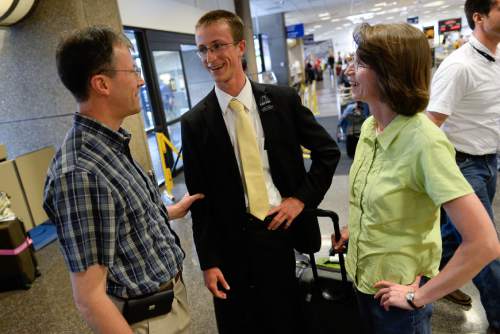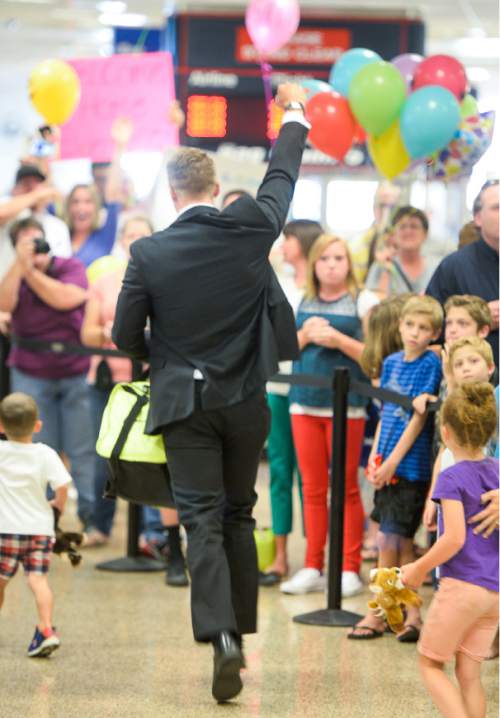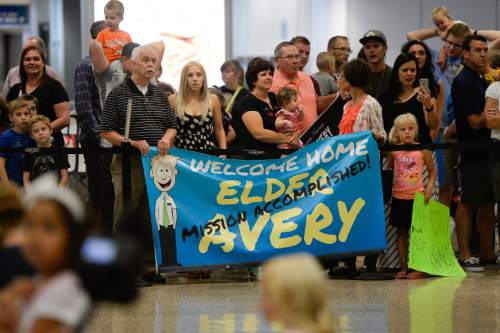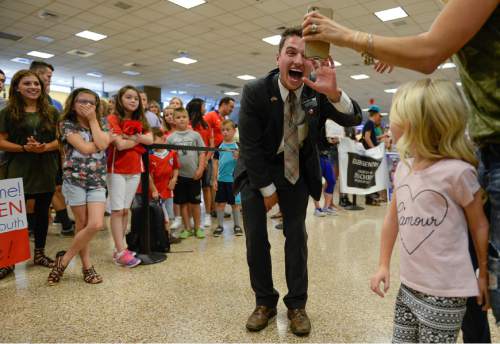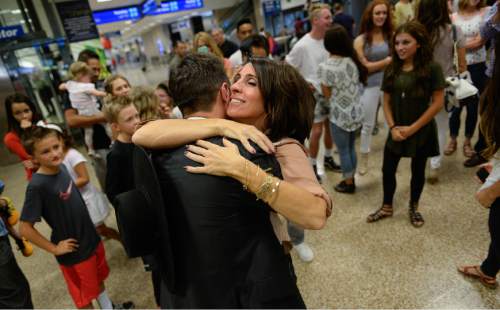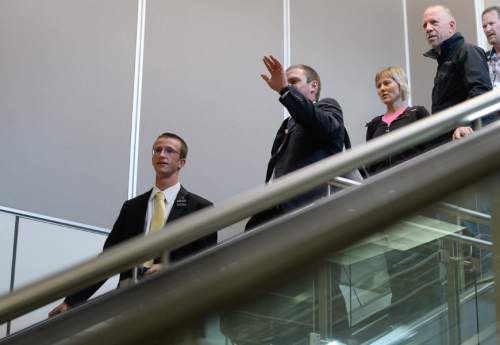This is an archived article that was published on sltrib.com in 2015, and information in the article may be outdated. It is provided only for personal research purposes and may not be reprinted.
As he stepped onto the airport escalator Tuesday, Taylor Ogden looked like every other returning Mormon missionary eager to reconnect with his family and friends, except he was sporting a black felt, hard-brimmed sombrero, the kind worn by Chilean cowboys.
Thirty members of his family exploded into cheers. In reaction, Ogden threw his arms skyward, part triumphant return, part dramatic wave hello. A videographer for the family caught all of the joyous, tearful reunions.
Just a minute before, Jacob Byers rode that same escalator, returning from his mission in San Diego. He walked past the bedlam of a dozen excited families, retrieved his bags and only then did he find his parents standing off to the side. No massive signs, flower leis or squeals of joy, though, after a brief hug, they headed home for a nice family lunch.
Ogden and Byers are among the first group of men to take advantage of a lower LDS missionary age. They left home when they were 18 and returned two years later with only a week to acclimate before starting another life-changing experience: college.
"I can't imagine it will be too hard," said Byers, a thin, bespectacled man with a no-nonsense look about him.
The Church of Jesus Christ of Latter-day Saints dropped the minimum missionary ages in fall 2012; for men, it went from 19 to 18 and, for women, 21 to 19. While only a year or two difference, it represents a seismic shift for young Mormons that upends longstanding educational and marriage trends and has resulted in a surge of 26,000 additional missionaries worldwide.
Exactly how this change affects Utah's universities remains uncertain. They saw a dramatic enrollment drop in 2013, when the equivalent of two missionary groups left at the same time: a rush of new female missionaries, along with the 18-year-old men joining the 19-year-olds already planning to go.
That tidal wave of outgoing missionaries started to return last spring, when the women began to come home, and it hits full force beginning this fall, with students like Byers heading to Utah State University and Ogden to Utah Valley University.
—
Missionary tracker • When church leaders announced the age change, USU administrators convened a task force within a day or two. They were deeply concerned the switch would crater the Logan-based school's enrollment. To head off the crisis, they took advantage of a new law that allowed them to give steeply discounted in-state tuition to nonresident students who had strong test scores.
USU also hired Leslie Buxton for a new position charged with tracking all students seeking deferments or leaves of absence. Aside from a few students with medical issues or in the military, that mainly means Mormon missionaries.
"I was hired to recruit them to come back," Buxton said, "and make sure their transition back is more seamless."
Other state schools, including UVU, the University of Utah and Weber State University, have stepped up efforts to track missionaries, focusing heavily on connecting with parents while prospective students are in the mission field.
USU has more data on its students' religious preferences than the state's other public colleges because of an optional question on its admissions application. Generally, universities are queasy about asking students to identify their religion, sexual orientation or other such demographic factors for fear that students will see those as figuring into whether they are admitted.
But USU has asked the voluntary question for more than a decade — a bit of information Katie Nielsen, USU's director of admissions, says is used only to better understand the demographics of the student body.
The data on the Logan campus, first reported by Mike Morales for USU's Hard News Cafe, show that, in 2012 — the year the missionary age changed — 71.6 percent of students voluntarily self-identified as Mormon. That percentage dropped to 65.9 percent the following year and remained unchanged in 2014. Numbers for this year are still preliminary.
John Mortensen, USU's assistant vice president for enrollment services, expects the LDS percentage to rise in the next couple of years as the missionaries return — if they come back to the school.
—
Gender gap? • Mortensen's concern is that female missionaries who leave when they are 19, will come home, marry and never graduate. State Higher Education Commissioner Dave Buhler shares that fear.
"Hopefully, they'll come back and finish," Buhler said. "We're hopeful. It's something we're going to be watching."
Buhler believes the historic shift might actually help boost graduation rates among men because they won't have to start college, take a two-year break and then return.
Eric and Sandy Byers, of Layton, believe their children — specifically 20-year-old Jacob and 18-year-old Rachel — may fit both of these gender-based expectations.
Eric Byers recalls being an unfocused high-school student who returned from his LDS mission in Chicago more mature. He believes his son will follow the same pattern, with the added benefit of not having an interrupted college experience.
"I think he'll come back and do much better," he said.
Nudged along by Buxton, who spends a lot of time reaching out to parents of missionaries, Eric Byers and his eldest son, Ben, picked Jacob's fall semester classes. He will start the day with calculus 2 with professor Claire Watson, followed by a computer science and then a physics course. Jacob Byers wants to be an electrical engineer.
His younger sister, Rachel, who just graduated from high school, seems to have selected an easier slate of USU courses for herself, including U.S. government and a class on the science of chocolate.
Jacob and Rachel will have separate apartments in the same complex. They will share a car, but after that first year, Rachel Byers will be 19 and plans to go on a Mormon mission of her own. When she returns, she may transfer to Weber State for an associate degree or, perhaps, she'll go directly to a private cosmetology school.
Why spend a year at college if she plans to be a cosmetologist?
She wants the university experience just as she wants the missionary experience. After that, she envisions getting married, having children, cutting hair. Rachel Byers knows that she intends to live out an LDS stereotype, in which men are expected to get degrees and hold jobs, while women see college as more of an optional experience — even though Mormon leaders urge women and men to obtain all the education they can.
But Rachel Byers believes people make the decision that's right for them.
"I always enjoyed doing things with my hands and I do better in a technical setting," she said. "Being able to do nails and hair, it is a skill I would like to have."
—
Greater expectations • Taylor Ogden's parents enrolled him in fall courses at Orem's UVU, where he'll take English and introduction to business management. That English course might come in handy, as Ogden had a hard time recalling certain English words at the airport after his two years immersed in Spanish in Chile. Despite the language stumbles, he said the mission will make him a far better college student, largely because he spent every morning studying scriptures.
"I love to learn now," he said.
Ogden's older sister, Alexis, is also a returned LDS missionary and their experiences have inspired their younger three sisters to follow suit.
The Byerses and the Ogdens see the missionary-age changes as a benefit to their children.
"It has been a great thing," said Trent Ogden, Taylor's father. "The girls are getting an expectation of going, without feeling the pressure to get married first. It is a great thing for our family."
Spiritual benefits aside, the state and its universities remain nervous about what these changes will mean in the long run. Administrators expect it to take a few more years for this major wave of missionaries to be absorbed back into the state's colleges — a change that will be studied intensely for some time to come.
— Annie Knox contributed to this article.
mcanham@sltrib.com Twitter: @mattcanham


